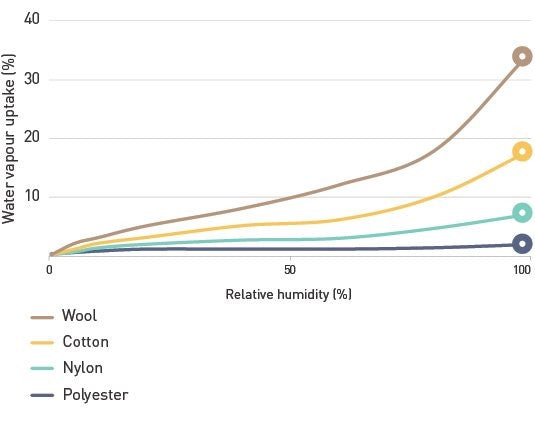The magic of Aussie Uggs genuine sheepskin boots is in the wool fibre that line sheepskin ugg boots and slippers. Wool will absorb large quantities of moisture, (in fact up to 35% its own weight). So, while being worn any sweat that is produced is quickly absorbed by the wool pile inner lining, then when you take the boots or slippers off, it evaporates leaving them fresh to wear the next day. Wool is what scientist call an ‘active fibre’, in that it can absorb and desorb moisture as the conditions around it change. (Dr Geoff Naylor, Wool fibre and its applications C.S.I.R.O Textile and Fibre Technology)
It is this unique property of wool that makes genuine Aussie Uggs sheepskin boots and slippers feel less clammy and more comfortable than footwear made from synthetic materials. Imitation sheepskin made from acrylic, does not absorb moisture, so the sweat accumulates and your feet always feel wet and clammy. As well your boots or slippers will quickly become 'smelly'. That is why it is so important to make sure the Ugg boots you are buying are made of genuine sheepskin.
Wool being an ‘active’ fibre reacts to changes in the body’s temperature, 'moderating' these changes so as to keep the wearer comfortable. When it is cold the insulating properties of wool keep your feet warm. On the other hand if your feet get hot and sweaty, the wool pile absorbs the moisture and allows air to circulate, thus cooling your feet. Accordingly, as with pure wool garments which are the most ‘breathable’ of all the common apparel fibres, sheepskin footwear is the most ‘breathable’ of any footwear. Even in a hot climate wool garments will be more comfortable to wear than synthetics and likewise, surprisingly, as many of our customers have found, genuine sheepskin Ugg boots and slippers are comfortable to wear even in summer.
How wool manages moisture and temperature
Technically wool is classed as a ‘hygroscopic’ fibre. (This is the term scientist use to describe wool’s ability to absorb and then dissipate moisture). Wool absorbs water vapour from its surrounding environment far more effectively than any other apparel fibre. Wool can absorb up to 35% of its weight before feeling wet and clinging to the skin. As absorption occurs, wool releases heat, keeping the wearer feeling warmer and drier in cold damp conditions or cooler and drier in hot humid conditions. One kilogram of dry wool can release heat equivalent to an electric blanket running for eight hours.
As mentioned above, wool protects the body against changes in temperature and moisture levels. Exercise for example, causes the body’s metabolic rate, and hence temperature, to rise. The body responds by initiating a cooling mechanism, sweat, to maintain its core temperature. Wool can absorb this sweat, leaving the skin dry, but at the same time maintain the cooling of the body that is induced by sweat. As physical exertion can take place in a range of environmental conditions – having woollen footwear and clothing that absorbs sweat and keeps the skin dry and body temperature well regulated - is much more comfortable than clothing or footwear that are not ‘temperature regulating’.
Moisture uptake of wool and other common apparel fibres.

Source: Dr Geoff Naylor, Wool fibre and its applications C.S.I.R.O Textile and Fibre Technology)
Wool's natural crimp provides superior insulation
One of the key features of wool is what is called ‘crimp’. Sheep wool fibres are not straight, but wavy, as can be seen in the photo below. The natural 'crimp' of the wool fibre traps pockets of air, insulating your skin from the cold environment and keeping you warmer, in much the same way as a wetsuit traps water that then heats up to the body’s core temperature and keeps the wearer warm, even in extremely cold water. As a result of the trapped air, wool maintains a dry ‘microclimate’ next to skin, keeping the wearer warm and dry. Synthetic fibres on the other hand have less or no ‘crimp’, so trap little air and are hence less effective in maintaining body temperature and do not preserve a dry micro-climate next to the skin.

Wool staple on an Australian Merino sheep displaying the ‘crimp’ or waves in the wool fibre.
Source: AWI 2015 An Introduction to Merino Visual Classing
Wool keeps you cooler in hot, dry environments
Contrary to popular opinion wool also keeps you cooler in warm environments. Wool fabrics can feel up to two times cooler to touch than synthetic fabrics, because wool conducts more heat away from your skin. When it is hot, wool keeps you cooler, by transferring moisture vapour away from the skin and allowing it to evaporate. Wool fabrics can remove 25% more moisture away from your skin than polyester fabrics, equivalent to an ambient temperature drop of up to four degrees Celsius.
Odour resistance
Wool is also naturally resistant to odour. Wool textiles are odour resistant due to the fibre’s unique, complex, chemical structure that enables it to absorb and lock away odours within the fibre, only releasing them upon washing. The wool pile lining of genuine sheepskin boots and slippers is also naturally odour resistant and will lock away odour. Everyone knows how ‘smelly’ feet can become when exercising, and how ‘smelly’ sneakers can get, especially if made from polyurethane. So, again genuine sheepskin ugg boots and slippers win ‘hands down’ when it comes to avoiding ‘smelly’ feet.
